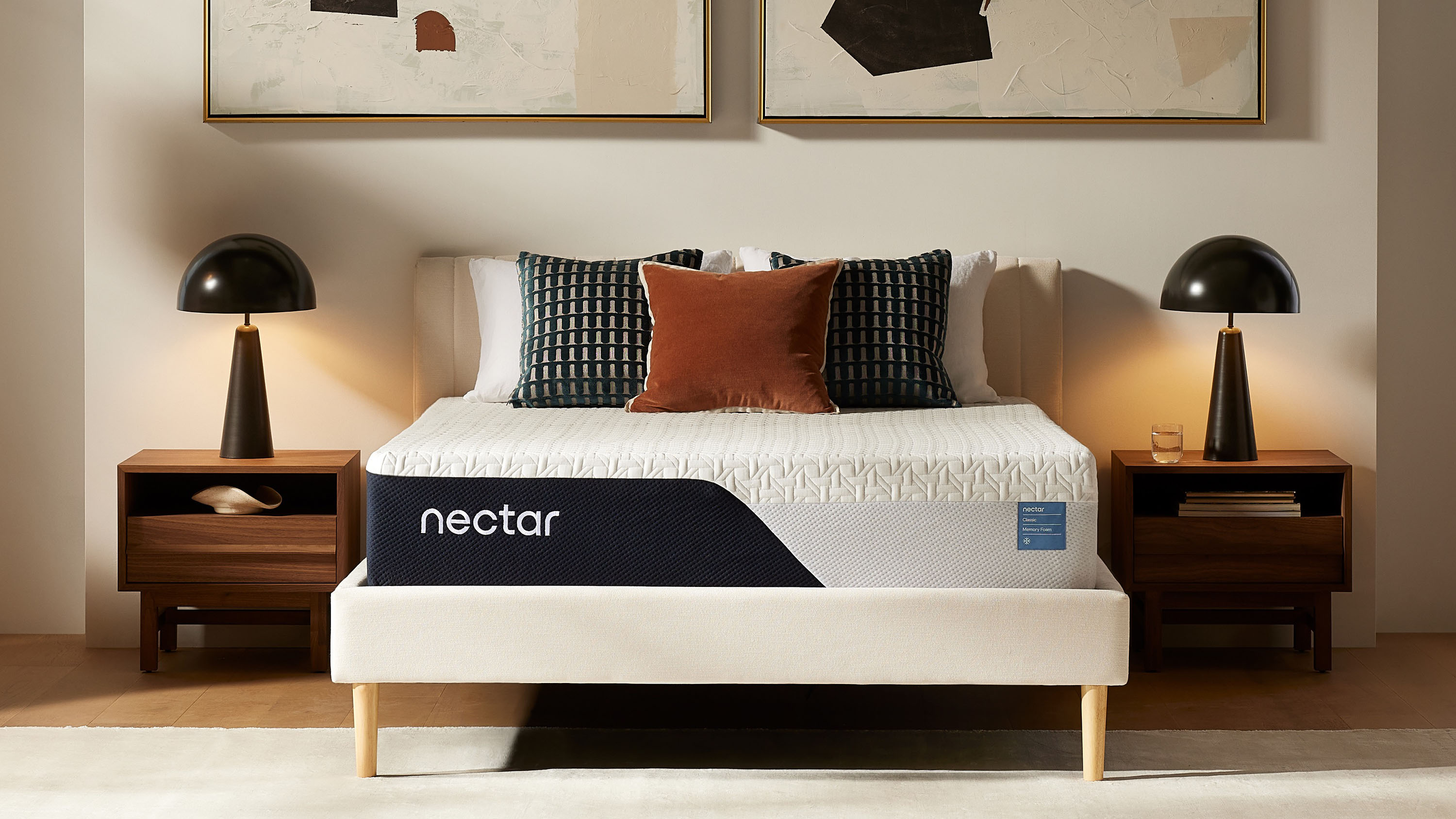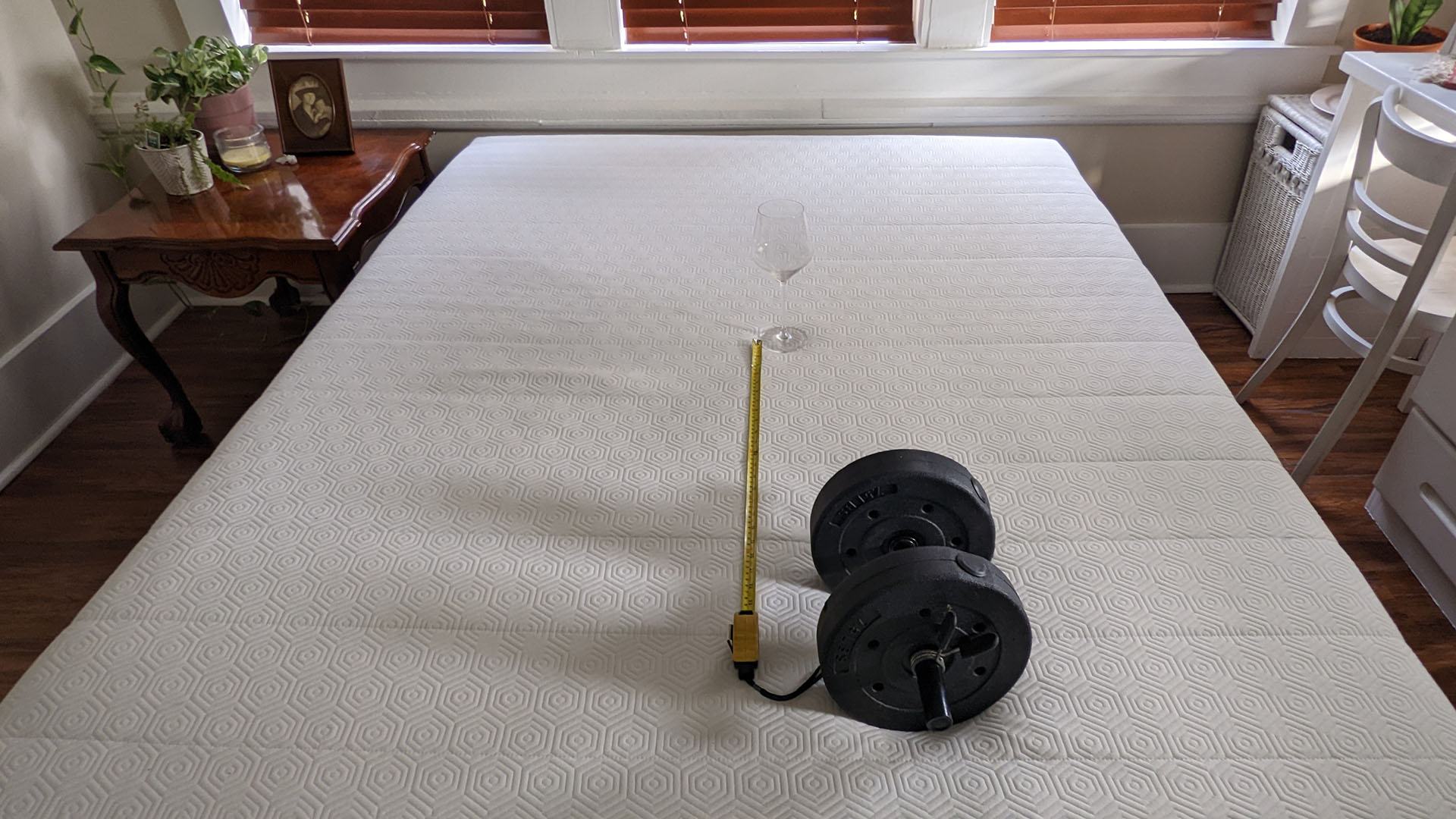
One of the first things to consider when buying a new mattress is what it's made from. For a body-hugging sensation a memory foam mattress is a sound choice, but if you need more support and airflow, a hybrid of foam and springs will be right for you. Each type has pros and cons, and we're sharing them below in our memory foam vs hybrid mattress showdown.
Our guide to the best mattresses of 2024 features memory foam and hybrid models across a range of specialties and price points. Speaking of cost, expect to spend more on hybrids than memory foam mattresses in general — but in either case, you'll always save during regular mattress sales. But don't shop before you know what you're looking for. Keep scrolling to learn more about the differences between memory foam and hybrid mattresses...
What is a memory foam mattress?
Memory foam, also known as viscoelastic polyurethane foam, was first developed in the 1960s by NASA as a way to improve the comfort and safety of their airline seats. Today, memory foam is used in mattresses, chairs and sofas, and even football helmets (to absorb shock).
Memory foam mattresses comprise a comfort layer, a transition layer, and a support core — all made of foam. Some brands include multiple foam comfort layers, as well as other types of poly foam for extra stability, pressure relief, and cooling.
What is a hybrid mattress?
Hybrid mattresses are made of foam and coils. The construction is largely the same as a memory foam mattress, except coils make up the support base instead of foam. Some designs use nanocoils or microcoils as transitional layers to provide contouring and aid airflow.
Many hybrid mattresses have reinforced edges for a broader sleep surface and stability when sitting on the sides of the bed. Plush pillow-tops and Euro tops are a staple of luxury hybrid mattresses.
Memory foam vs hybrid mattress: Key differences
- Memory foam beds excel at pressure relief and motion isolation
- Hybrids are generally more supportive, bouncier, and cooler
- Hybrids are typically pricier than memory foam mattresses
The obvious difference between memory foam and hybrid mattresses is their construction. Memory foam mattresses are made exclusively of foam, whilst hybrids use foam and springs. Hybrids are typically pricier than all-foam mattresses as the former includes more materials.
Memory foam mattresses are known for their excellent motion isolation as there are no springs for the movement to travel. They're also a great choice for anyone with joint pain as the foams will evenly distribute body weight, relieving pressure points in the shoulders, hips, and knees. However, some sleepers may find it difficult to move around and feel 'stuck.' Not everyone likes feeling hugged by their mattress.

Most hybrid mattresses will make you feel as if you're floating atop the surface. The reactive flex of the springs provides a stronger foundation with push-back support for your weight. (Most of the best mattresses for heavy people are hybrids.) The springs of a hybrid can also help with airflow, edge support, and ease of movement. On the other hand, hybrids may not limit movement as well as foam mattresses.
There are memory foam and hybrid mattresses to suit a variety of sleep styles and body types. The one you should choose will come down to what you prioritize in a mattress.
Memory foam vs hybrid mattress: Price
- Memory foam and hybrid mattresses span all price points
- Hybrids can cost $100 - $600 more than their all-foam counterparts
- However, both types are regularly discounted during major sales
Memory foam mattresses tend to cost less than hybrid mattresses, but you'll find either type in the budget, mid-range, or premium price brackets. Some memory foam models come in hybrid versions, which can add least least $100 more to the final price. That said, there are outliers like the DreamCloud Hybrid Mattress, which sells for less than its all-foam counterpart.
Below is a cost comparison between the memory foam and hybrid versions of flagship mattresses from some of the top sleep brands:
Most of these mattresses are rarely ever sold at full price, but even after discounts, you'll still pay more for a hybrid than all-foam. Deals do vary throughout the year. The best time to buy a mattress on sale is during larger holiday events such as Black Friday, Labor Day, and Presidents' Day.
Memory foam vs hybrid mattress: Comfort & support
- Both types are available in a range of firmness levels
- For deep pressure relief, choose a memory foam mattress
- For support and responsiveness, go with a hybrid mattress
Memory foam mattresses offer exceptional relief because they respond to pressure and heat to mold around your body. This helps reduce stress on your shoulders, hips, and back. The contouring nature of memory foam will allow your spine to remain neutral, making it a good option for sleepers with back or joint pain.

Hybrid mattresses may offer a better balance of relief and support for many sleepers because they combine the contouring of foam with the supportive flex of springs, preventing you from sinking too low. The responsiveness of the springs makes it a lot easier to move around, as well — ideal if you’re a combi sleeper.
Both memory foam and hybrid mattresses come in a range of firmness levels so you can find something to suit your preferences, but keep in mind that hybrids are usually more supportive than memory foam beds for sleepers over 200lbs.
Memory foam vs hybrid mattress: Performance
- Memory foam is ace for absorbing movement
- Hybrids are naturally more breathable for cooler sleep
- Hybrids also tend to have stronger edge support
Motion transfer

Whilst some hybrid mattresses do a good job of isolating movement, memory foam mattresses are usually better at limiting motion transfer from one side of the bed to the other. Foam is great at absorbing shock, which is why it's used in football helmets and running shoes.
If you want to sleep on a hybrid without being disturbed by a restless partner, look for individually encased or zoned coils. These help minimize motion transfer since they're encased in their own fabric pockets instead of connected. (Alternatively, you can buy a split king mattress, if available.)
Temperature regulation

Memory foam mattresses have a reputation for sleeping hot because there’s not much space for air to move around within the thick layers of foam. They also rely on your body heat to change the state of the foam, which allows it to contour to your body but absorbs that body heat. Firmer memory foam mattresses tend to sleep cooler due to the lack of sinkage.
Hybrid mattresses naturally sleep cooler because their coils allow air to circulate. If you deal with severe night sweats and hot flashes, a cooling mattress will be your best bet. These have specialty materials that wick away heat and moisture. Many of them are hybrids, but some are completely made of foam. In fact, we consider the GhostBed Luxe memory foam mattress the number one-ranked cooling model.
Edge support

Most memory foam mattresses don’t do so well when it comes to edge support as hybrids. If you like to sleep close to the edge or sit on the side of the bed to put your shoes on, the foam will dip and sink easily so you’ll feel like you’re going to roll off. We have encountered some exceptions, though, like the Bear Original memory foam mattress.
Hybrid mattresses, on the other hand, are generally known for their edge support. Many hybrid designs have firmer coils along the perimeter for stronger edges, which can also help with premature sagging. Keep in mind that adding a pillow-top to a hybrid mattress may diminish the quality of its edge support.
Memory foam vs hybrid mattress: Durability
- Both mattress types have an average life span of 7-10 years
- High-density foam and thick coils are best for durability
- Proper at-home care can prolong the life of your mattress
All mattresses have a lifespan, no matter how much money you pay. When it comes to memory foam vs hybrid, both have an average lifespan of 7-10 years. Of course, this depends on the quality of the materials used. High-density foams and thick coils will help a mattress last longer.
When it comes to which mattress is best for durability, both have their strengths. Hybrid mattresses do tend to keep their shape better because the innerspring coils offer a stronger base so it’s less likely to dip and sag over time. On the other hand, those coils are also a weakness as they can weaken or break over time, making it less supportive. However, most coils used in modern mattresses these days are pretty strong so that is unlikely to happen.

Memory foam mattresses will last a long time with proper care, but they're more prone to developing permanent indentations where a person sleeps. Also, because memory foam can trap heat, moisture can build up, causing the materials to deteriorate. (Similarly, pillow-top hybrid mattresses may have these issues, too.)
Whether you have a memory foam or hybrid mattress, regular maintenance like deep cleaning your mattress at home and buying one of the best mattress protectors can help prolong its lifespan. Rotating your mattress is another way to help keep your mattress in tip-top shape for longer.
Memory foam vs hybrid mattress: Which one should you buy?
Buy a memory foam mattress if…
✅ You share a bed: One of the standout features of a memory foam mattress is superb motion isolation. If you share a bed with a restless partner or even a pet, you’re less likely to be disturbed by their movements at night.
✅ You crave deep pressure relief: Memory foam will hug your body and take the pressure off your knees, hips, and shoulders. It's an excellent choice for sleepers with joint pain or those who like to sink into their mattress.
✅ You have a smaller budget: Yes, there are luxury memory foam mattresses (see: Tempur-Pedic) but on the whole, all-foam beds cost less than hybrids.
Buy a hybrid mattress if...
✅ You’re a warm sleeper: Hybrid mattresses are naturally cooler than memory foam beds because of their coils. If you don't need a heavy-duty cooling model, a standard hybrid should at least help you sleep temperature-neutral.
✅ You have a larger body type: Compared to memory foam, hybrid mattresses are more supportive for heavier sleepers. The coils of a hybrid help prevent deep sinkage.
✅ You like to use your entire sleep surface: Hybrid mattresses are known for having stronger edges than all-foam models, which means you can sprawl out or sit on the side of your bed without fear of falling over.
Memory foam vs hybrid mattress: Bottom line
Memory foam mattresses conform to your body and offer great pressure relief, but they can sleep hot and aren’t great for heavier sleepers. A hybrid offers the best of both worlds — you get the contouring of memory foam with the support and breathability of a traditional innerspring mattress.
Remember that this is a general guide. Our testers have come across memory foam beds that are cooling and firm, Likewise, we've slept on hybrids that limit movement well and are lusciously plush. Reading reviews from customers and professionals alike can give you an idea of what to expect.
No matter which mattress type you choose, buy according to your sleep needs and stay within your budget. If you're keen to switch from a memory foam mattress to a hybrid (or vice versa), use the trial period to adjust to the different bed feel. Fortunately, mattress trials are common and can last up to a year.







